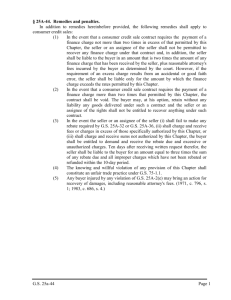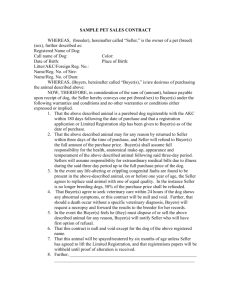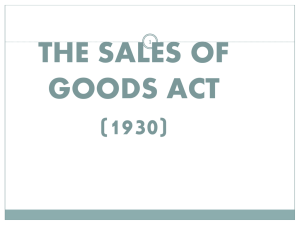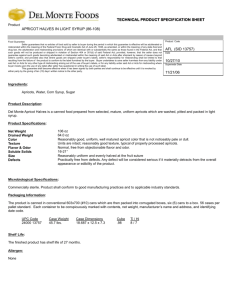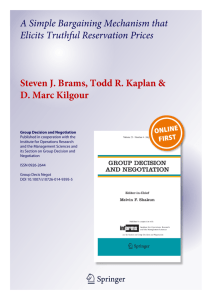Paying the Expected Externality for a Price Quote Achieves
advertisement
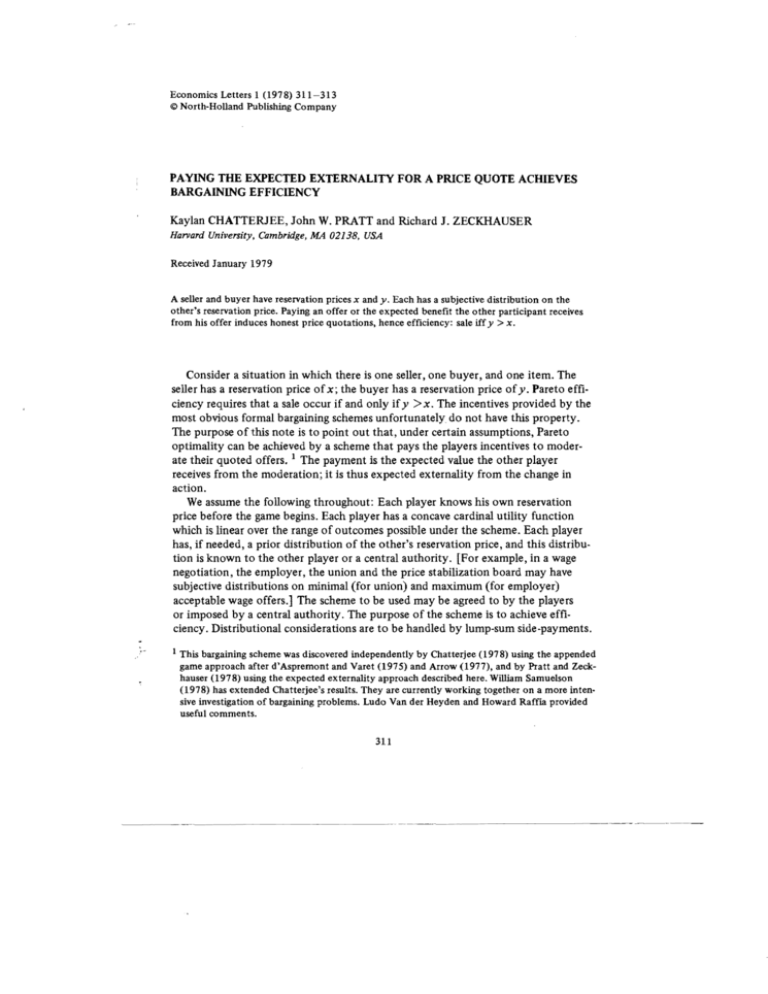
Economics Letters 1 (1978) 311-313
North-Holland Publishing Company
@
PAYING THE EXPECTED EXTERNALITY FOR A PRICE QUOTE ACWEVES
BARGAINING EFFICIENCY
Kaylan CHATTERJEE, John W. PRATT and Richard J. ZECKHAUSER
Harvard University, Cambridge, MA 02138, USA
Received January 1979
A seller and buyer have reservation prices x and y. Each has a subjective distribution on the
other's reservation price. Paying an offer or the expected benefit the other participant receives
from his offer induces honest price quotations, hence efficiency: sale iff y > x.
Consider a situation in which there is one seller, one buyer, and one item. The
seller has a reservation price of x; the buyer has a reservation price of y. Pareto effi­
ciency requires that a sale occur if and only if y >x. The incentives provided by the
most obvious formal bargaining schemes unfortunately do not have this property.
The purpose of this note is to pOint out that, under certain assumptions, Pareto
optimality can be achieved by a scheme that pays the players incentives to moder­
ate their quoted offers. 1 The payment is the expected value the other player
receives from the moderation; it is thus expected externality from the change in
action.
We assume the following throughout: Each player knows his own reservation
price before the game begins. Each player has a concave cardinal utility function
which is linear over the range of outcomes possible under the scheme. Each player
has, if needed, a prior distribution of the other's reservation price, and this distribu­
tion is known to the other player or a central authority. [For example, in a wage
negotiation, the employer, the union and the price stabilization board may have
subjective distributions on minimal (for union) and maximum (for employer)
acceptable wage offers.] The scheme to be used may be agreed to by the players
or imposed by a central authority. The purpose of the scheme is to achieve effi­
ciency. Distributional considerations are to be handled by lump-sum side-payments.
1 This bargaining scheme was discovered independently by Chatterjee (1978) using the appended
game approach after d'Aspremont and Varet (1975) and Arrow (1977), and by Pratt and Zed­
hauser (1978) using the expected externality approach described here. William Samuelson
(1978) has extended Chatterjee's results. They are currently working together on a more inten­
sive investigation of bargaining problems. Ludo Van der Heyden and Howard Raffia provided
useful comments.
311
K. Chf{tterjee et al. I Bargaining efficiency
312
Scheme 1. Successive decisions. (a) Seller first. The seller must make an offer to
sell at a price z. If the buyer accepts, the sale occurs at this price. Otherwise no sale
occurs. Whether or not the offer z is accepted, the seller receives an incentive pay­
ment s(z) - c, where c is any constant side-payment from seller to buyer. If the
seller's prior cumulative distribution of the buyer's reservation price y is G, then
s(z)
J (y
z) dG(y) .
(1)
z
This is the seller's expectation of the value to the buyer of the offer z, elsewhere
called the expected externality [Pratt and Zeckhauser (1978)]. We shall assume that
the incentive s(z) is paid by the buyer, though it could be paid in part or in toto by
a third party without effect on incentives or efficiency as long as the scheme gives
the buyer no influence on the portion of s(z) he must pay.
Under this scheme the buyer should, of course, accept if and only if y > z.
(Acceptance if y = z makes no essential difference in what follows.) The seller's
expected gain is then
c + (z - x)[l
s(z)
G(z)]
=
J (y -x) dG(y)
c.
(2)
z
This is maximized at z x, since the integrand is negative for y <x and positive for
y > x. Thus honesty and hence Pareto efficiency are induced. More specifically, the
buyer has a unique, dominant strategy; the seller has a unique optimum response;
the resulting pair of strategies is a unique equilibrium and is Pareto efficient.
At equilibrium, the seller faces no risk, gaining sex) - c with certainty, while the
expectation of the buyer's gain according to the seller's prior distribution G is c.
Thus, for c =0, the seller reaps all the joint profits. Any desired division of the
expected gains can be achieved through choice of the lump-sum side-payment c.
We note, to facilitate comparison with the literature, that the familiar integration
of (I) by parts gives
s(z)
=
J [1
(3)
G(y)] dy .
z
(b) Buyer first. If the buyer must make an offer w which the seller must accept
or reject, then honesty and efficiency are induced by paying the buyer the incentive
t(w) + c, where
w
t(w) =
w
J (w - x) dF(x) = J F(x) dx ,
(4)
K. Chatterjee et al. I Bargaining efficiency
313
when the buyer's prior cumulative distribution of the seller's reservation price x is
F.
Scheme 2. Simultaneous decisions. The buyer and seller must simultaneously make
offers wand z. Ifw >z, the sale occurs at the price aw + (1- a)z, where a is a con­
stant between 0 and 1; otherwise, no sale occurs. Whether or not a sale occurs, both
players receive expected externality incentive payments to moderate their price
requests. These payments are at (w) and (1 a)s(z). Honest quotes still produce a
Pareto optimal equilibrium. Unlike Scheme I, however, neither player has a domi­
nant strategy or automatic incentive for honesty since neither moves second. The
distributions F and G are each, as before, one player's conditional distribution, given
his reservation price, of the other player's reservation price. The players (and the
central authority, if any) would know these distributions if, for example, the reser­
vation prices were originally drawn independently from publicly known distributions
Fand G.
Example. Suppose that x is uniform on the interval [0,2] andy is uniform on [1,3].
Under Scheme 1(a) (seller first), the expected externality incentive payment s(z) to
the seller is
2
z if z ~ 1;
1(3 - zi
if 1 ~ z ~ 3;
o
if z ~ 3.
(5)
The seller's expected gain is maximized by the honest quotation z = x, which also
eliminates all risk ex post (when the seller knows x). Full efficiency is achieved. Ex
ante, the total expected gain is 25/24 and the probability of sale is 7/8. Setting c =
-25/48 would divide the expected gains from the bargaining process equally.
In the absence of any)ncentive payment, the seller's expected gain is maximized
by quoting z = (x + 3)/2, and ex ante the total expected gain is 13/16, only 78% of
the Pareto optimum, and the probability of sale is only 1/2.
Conclusion. Bargaining is one of a host of interactive decision situations in which
information is not fully shared where the payment to each player of the expected
externality generated by his action achieves efficiency. This result is particularly
surprising in the bargaining context.
References
d'Aspremont, C. and Gerard-Varet, L.A., 1975, Individual incentives and collective efficiency for an externality game with incomplete information, CORE Discussion paper no. 7519. Arrow, K.J., 1977, Property rights and demand revelation under incomplete information, Dis­
cussion paper no. 580 (Harvard Institute of Economic Research, Cambridge, MA). Chatterjee, K., 1978, A proposal for thesis research in interactive decision problems with differ­
ential information, Mimeo. (Harvard University, Cambridge, MA). Pratt, J.W. and R.J. Zeckhauser, 1978, Incentives-based schemes for externalities and decentrali­
zation, Mimeo. (Harvard University, Cambridge, MA). Samuelson, W., 1978, First offer bargains, Mimeo. (Boston University, Boston, MA). - - - - - - - - - - - - - - - - - - - - - _........
- - -
.­



